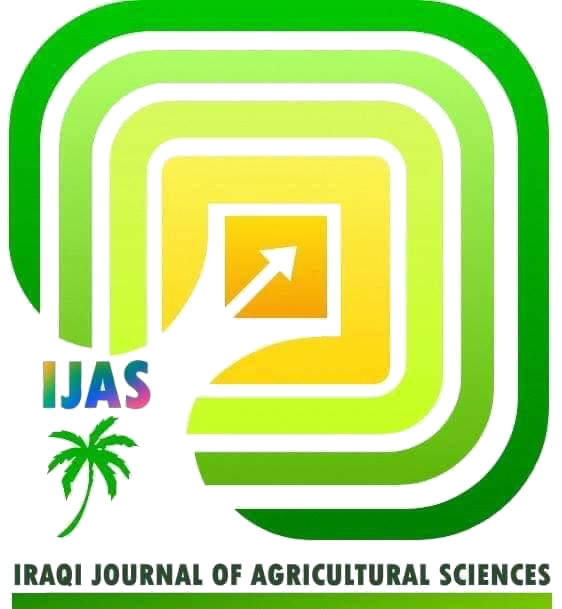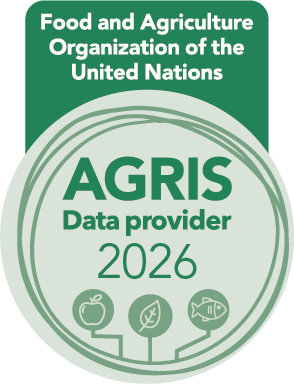ENHANCEMENT OF ACTIVE COMPOUNDS PRODUCTION AND STUDYING THE GENETIC VARIATION IN CALLUS OF OREGANO BY ADDING NANOMATERIALS
DOI:
https://doi.org/10.36103/5c1rfm10Keywords:
Callus cultures, nanoparticles, phenolic compounds, RAPD-PCR.Abstract
This study aimed to investigate the stimulation of the formation of phenolic compounds in callus cultures of Origanum vulgare using nanomaterials. Different combinations of plant growth regulators (NAA, BAP, and TDZ) were applied to form the calli from leaf explants. The optimal effect was achieved with a combination of 1 mg/L NAA and 0.5 mg/L BAP, which resulted in an initiation rate of 100% along with significant increase in both fresh and dry weight. The addition of silver nanoparticles (Ag-NPs) and titanium dioxide nanoparticles (TiO2-NPs) at different concentrations (1, 2, and 3 mg/L) to the culture medium led to a substantial decrease in the fresh and dry weight of calluses with a significant increase in the content of tested phenolic compounds compared to the control. The effective treatment was 2 mg/L Ag-NPs, which enhanced the production of most phenolic compounds. Additionally, the RAPD-PCR study indicated the presence of genetic variation in the callus cultures under nanoparticle stress.
References
1. Abdallah, S., M. Yakoup and M. Abdalla. 2017. Micropropagation of oregano (Origanum syriacum L.) through tissue culture technique. J. Plant Prod. 8(5): 635–639. Doi: 10.21608/jpp. 40497.
2.Abed, A.S., D.M. Majeed, M.A. Mohammed and A.M.J. Al-Jibouri. 2020. In vitro influences of sugar nutrition and light condition on accumulation of some phytochemicals in Verbascum thapsus L. Culture. Plant Archives, 20(1), 1126–1130.
3. Al-Jibouri, A.M.J., A.S. Abed, Z.S. Hussin and A.A., Abdulhusein. 2017. Effect of nanoparticles on in vitro microtuberization of potato cultivars (Solanum tuberosum L.). Journal of Biotechnology Research Center, 11(1), 57–61.
4. Alekseeva, M., T. Zagorcheva, I. Atanassov and K. Rusanov. 2020. Origanum vulgare L. – A review on genetic diversity, cultivation, biological activities and perspectives for molecular breeding. Bulgarian Journal of Agricultural Science. 26(6): 1183–1197.
5. Ali, A., S. Mohammad, M.A. Khan, N.I. Raja, M. Arif, A. Kamil and Zia-Ur-Rehman Mashwani. 2019. Silver nanoparticles elicited in vitro callus cultures for accumulation of biomass and secondary metabolites in Caralluma tuberculate. Artif. Cells, Nanomedicine, Biotechnol. 47(1): 715–724. Doi: https://doi.org/10.1080/21691401.2019.1577884.
6. Coskun, Y., and G. Kapdan. 2025. Silver Nanoparticles (AgNPs) Act as Nanoelicitors in Melissa officinalis to Enhance the Production of Some Important Phenolic Compounds and Essential Oils. Flavour and Fragrance Journal, 40(2), 278-288. https://doi.org/10.1002/ffj.3823
7. Chenga, F., Y.-F. Liua, G.-Y. Lub, X.-K. Zhangb, L.-L. Xie, C.-F. Yuana and B.-B. Xu. 2016. Graphene oxide modulates root growth of Brassica napus L. and regulates ABA and IAA concentration. Journal of Plant Physiology, 193, 57–63. https://doi.org/https://doi.org/10.1016/j.jplph.2016.02.011
8. Fehér, A. 2019. Callus, dedifferentiation, totipotency, somatic embryogenesis: What these terms mean in the era of molecular plant biology?. Front. Plant Sci. 10. Doi: https://doi.org/10.3389/fpls.2019.00536.
9. Hegazi, G.A., W.M. Ibrahim, M.H. Hendawy, H.M. Salem and H. E. Ghareb. 2020. Improving α-tocopherol accumulation in Argania spinosa suspension cultures by precursor and nanoparticles feeding. Plant Arch. 20(2): 2431–2437.
10. Heydari, H.R., E. Chamani and B. Esmaielpour. 2020. Cell line selection through gamma irradiation combined with multi‑walled carbon nanotubes elicitation enhanced phenolic compounds accumulation in Salvia nemorosa cell culture. Plant Cell, Tissue and Organ Culture. https://doi.org/https://doi.org/10.1007/s11240-020-01867-6
11. Hrncic, M.K., D. Cör, J. Simonovska, Ž. Knez, Z. Kavrakovski and V. Rafajlovska. 2020. Extraction techniques and analytical methods for characterization of active compounds in Origanum species. Molecules. 25(4735). doi:10.3390/molecules25204735.
12. Hurný, A., C. Cuesta, N. Cavallari, K. Ötvös and J. Duclercq. 2020. Synergistic on auxin and cytokinin: positively regulates growth and attenuates soil pathogen resistance. Nat. Commun. 11(2170).
Doi: 10.1038/s41467-020-15895-5.
13. Jathunarachchi, A.S., P.I.P. Perera and A.S.A. Salgadoe. 2021. Plant genetic resources assay for abiotic stress-tolerant traits using tissue culture techniques: A review. In Sabrao Journal of Breeding and Genetics (Vol. 53, Issue 3, pp. 334–351).
14. Jampílek, J., K. Kráľová, 2023. Impact of Abiotic Stresses on Production of Secondary Metabolites in Medicinal and Aromatic Plants. In: Aftab, T. (eds) New Frontiers in Plant-Environment Interactions. Environmental Science and Engineering. Springer, Cham. https://doi.org/10.1007/978-3-031-43729-8_8
15. Jan, M. W. and J. Naskar. 2021. Assessment of phytochemical enhancement in Catharanthus roseus by silver nanoparticle Manar. Pharma Innov. J. 10(2): 483–486. Doi: https://doi.org/10.22271/tpi.2021.v10.i2g.5709
16. Jiménez, V.M. and F. Bangerth. 2001. Endogenous hormone levels in explants and in embryogenic and non-embryogenic cultures of carrot. Physiologia Plantarum. 111(3): 389–395.
Doi: 10.1034/j.1399-3054.2001.1110317.x.
17. Jordan, J.T., K.P. Singh and J.E. Cañas-Carrell. 2018. Carbon-based nanomaterials elicit changes in physiology, gene expression, and epigenetics in exposed plants: A review. Current Opinion in Environmental Science and Health. 6: 29–35.
doi: 10.1016/j.coesh.2018.07.007.
18. Karimzadeh, F., R. Haddad, G. Garoosi and R. Khademian. 2019. Effects of nanoparticles on activity of lignan biosynthesis enzymes in cell suspension culture of Linum usitatissimum L. Russ. J. Plant Physiol. 66(5): 756–762. Doi: 10.1134/S1021443719050078.
19. Kaul, S.C. and R. Wadhwa. 2017. Science of Ashwagandha: Preventive and therapeutic potentials. Springer, Doi: 10.1007/978-3-319-59192-6.
20. Khorsand G.J., M.R. Morshedloo, H. Mumiv and, Z.E. Bistgani, F. Maggi and A. Khademi. 2022. Natural diversity in phenolic components and antioxidant properties of oregano (Origanum vulgare L.) accessions, grown under the same conditions. Sci. Rep. 12(5813). doi: 10.1038/s41598-022-09742-4.
21. Korkor, A.M., S.A. Mohamed, O.M. Abd El-kafie and A.A. Gohar. 2017. Adaptation of the in vitro culture of Origanum majorana L. for production of phenolic acids. J. Pharm. Biol. Sci. 12(2): 30–38. DOI: 10.9790/3008-1202013038.
22. Marslin, G., C.J., Sheeba and G. Franklin. 2017). Nanoparticles alter secondary metabolism in plants via ROS burst. Frontiers in Plant Science, 8(May), 1–8. https://doi.org/10.3389/fpls.2017.00832
23. Mehrian S.K. and R. De Lima. 2016. Nanoparticles cyto and genotoxicity in plants: Mechanisms and abnormalities. Environ. Nanotechnology, Monit. Manag. 6: 184–193. Doi: http://dx.doi.org/10.1016/j.enmm.2016.08.003.
24. Miryeganeh, M. and H. Saze. 2020. Epigenetic inheritance and plant evolution,” Popul. Ecol., vol. 62: 17–27. Doi: 10.1002/1438-390X.12018.
25. Murashige, T. and F. Skoog. 1962. A revised medium for rapid growth and bio assays with Tobacco tissue cultures. Physiol. Plant. 15: 473–497.
26. Nurzyńska-Wierdak, R., and M. Walasek-Janusz 2025. Chemical composition, biological activity, and potential uses of oregano (Origanum vulgare L.) and oregano essential oil. Pharmaceuticals, 18(2), 267. https://doi.org/10.3390/ph18020267
27. Nouroz, E., B. Hosseini, R. Maleki and B. Mandoulakani. 2019. Iron oxide nanoparticle a novel elicitor to enhancing anticancer flavonoid production and gene expression in Dracocephalum kotschyi hairy root cultures. J. Sci. Food Agric.
Doi: https://doi.org/10.1002/jsfa.9921.
28. Parra, C., P. Muñoz, H. Escobar, L. Bustos, F. Parra, M.J. Simirgiotis and H. Escobar. 2021. UHPLC-DAD characterization of Origanum vulgare L. from Atacama Desert Andean region and antioxidant, antibacterial and enzyme inhibition activities. Molecules. 26(2100).
doi: https://doi.org/10.3390/molecules26072100.
29. Sabir, F.N., S. Sangwan, N.D. Chaurasiya, L.N. Misra and R.S. Sangwan. 2008. In vitro withanolide production by Withania somnifera L. cultures,” Zeitschrift fur Naturforsch. - Sect. C J. Biosci. 63(5–6): 409–412.
Doi: 10.1515/znc-2008-5-616.
30. Sobhannizadeh, A., M. T. Giglou, M. Behnamian, A. Estaji, M. Majdi, and A. Szumny, 2025. The effect of plant growth regulators, FeO3-CTs nanoparticles and LEDs light on the growth and biochemical compounds of black seed (Nigella sativa L.) callus in vitro. BMC Plant Biology, 25(1), 539. https://doi.org/10.1186/s12870-025-06423-y
31. Seltman, H.J. 2018. Experimental Design and Analysis. Carnegie Mellon University. pp: 428.
32. Shin, S.W. Song, I. H. and S.H. Um. 2015. Role of physicochemical properties in nanoparticle toxicity,” Nanomaterials, vol. 5, pp. 1351–1365. Doi: 10.3390/nano5031351.
33. Soltani, S., A. Shakeri, M. Iranshahi and M. Boozari. 2021. A review of the phytochemistry and antimicrobial properties of Origanum vulgare L. and subspecies. Iran. J. Pharm. Res. 20(2): 268–285. doi: 10.22037/ijpr.2020.113874.14539.
34. Srivastava, L.M. 2002. Plant Growth and Development: Hormones and environment, 1st ed. Oxford: Academic Press., (Online). Available, pp: 772. https://books.google.com/books?id=wXLBKdncciQC&pgis=1
35. Tariverdizadeh, N., M. Mohebodini, E. Chamani and A. Ebadi. 2021. Iron and zinc oxide nanoparticles: An efficient elicitor to enhance trigonelline alkaloid production in hairy roots of fenugreek. Ind. Crops Prod. 162(113240). doi: 10.1016/j.indcrop.113240.
36. Tymoszuk, A and D. Kulus. 2020. Silver nanoparticles induce genetic, biochemical, and phenotype variation in Chrysanthemum. Plant Cell. Tissue Organ Cult. 143: 331–344. doi: 10.1007/s11240-020-01920-4.
37. Yaaqoob, L.A., R.M. Abed, Z.K. Kamona, M.F. Altaee and R.W. Younis. 2022. Evaluation the ability of titanum oxide nanoparticles to increase the production of prodigiosin and phenasine from Serratia marcescens and Pseudomonas aeruginosa respectively. Iraqi Journal of Agricultural Sciences, 53(3), 496–504. https://doi.org/10.36103/ijas.v53i3.1557
Downloads
Published
Issue
Section
License
Copyright (c) 2025 IRAQI JOURNAL OF AGRICULTURAL SCIENCES

This work is licensed under a Creative Commons Attribution-NonCommercial 4.0 International License.

2.jpg)


